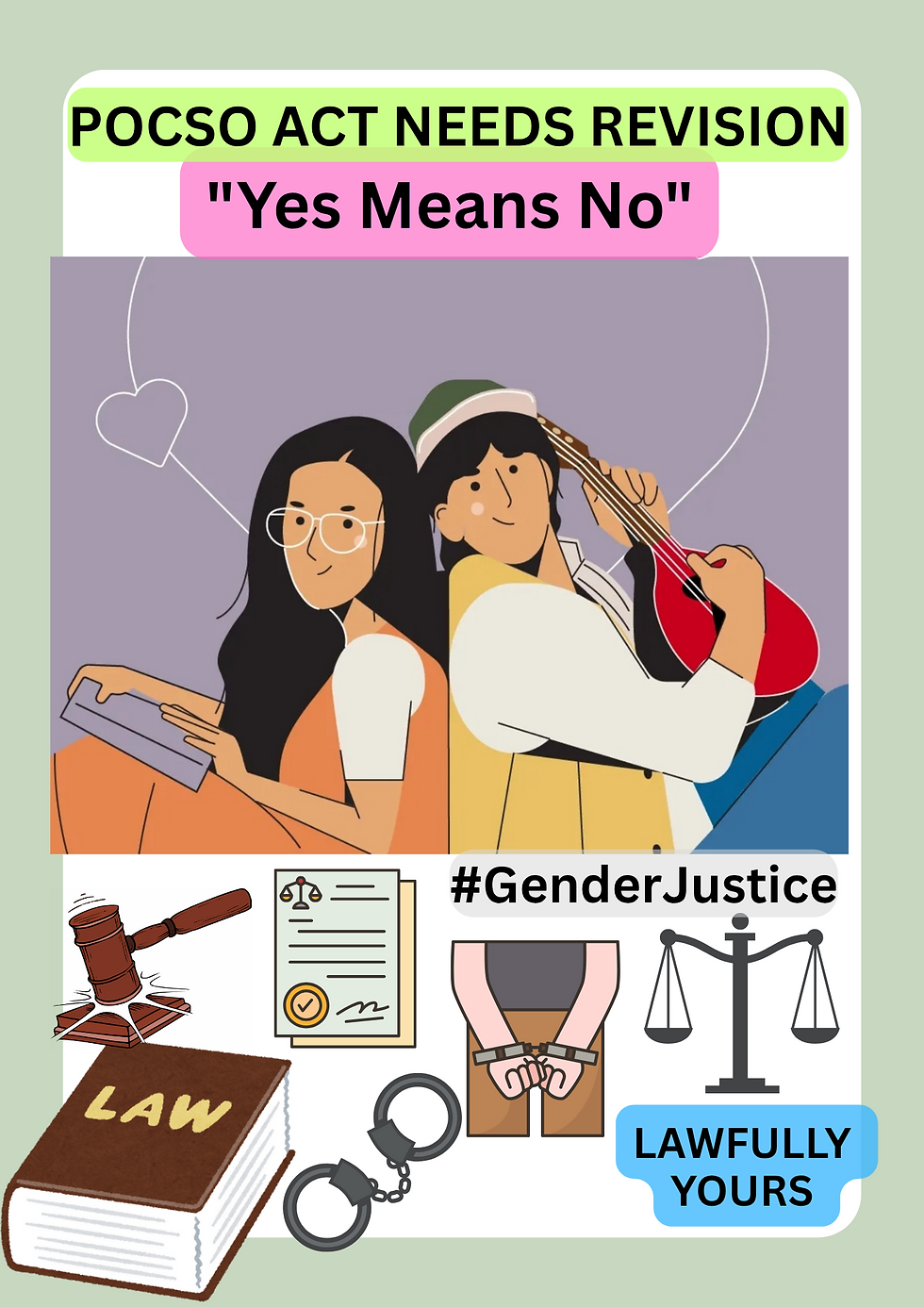💕ROMEO JULIET LAW AND INDIAN JURISPRUDENCE🔍: POCSO ACT NEEDS REVISION⚖️
- Subhodeep Chattopadhyay
- Aug 8
- 6 min read

Romeo Juliet Law in India 2025: POCSO Act Reform, Sexual Consent Age & Supreme Court Guidelines ⚖️💕
🔍 Introduction: A Legal Paradox
The Indian legal landscape presents a fascinating contradiction when it comes to sexual autonomy and consent. While society champions the principle of "No Means No" 🚫 through movements popularized by films like Pink, our legislative framework under the Protection of Children from Sexual Offences Act (POCSO) 2012 operates on an entirely different premise - one where "Yes Means No" for individuals under 18 years of age. 🧒
This paradoxical "Yes Means No" principle under POCSO symbolizes that any consent given by a minor is legally invalid and meaningless, regardless of their expressed willingness or understanding. 🔒
This blog explores the complex intersection of consent, legal capacity, and sexual autonomy, analyzing the "Yes Means No" paradigm where minor's consent is rendered legally void, and examining recent developments in Indian jurisprudence regarding the potential for Romeo-Juliet laws to bridge this gap. 🌉
📚 The Current Legal Framework: POCSO's Absolute Approach
🛡️ POCSO's "Yes Means No" Doctrine
Under the Protection of Children from Sexual Offences Act, 2012, the law creates a legal reality where "Yes Means No" for all minors:
Any sexual activity with a person under 18 years is automatically criminal 🚨
Consent is legally invalid - a minor's "yes" is transformed into a legal "no" ❌
Section 4 establishes strict liability for penetrative sexual assault 📖
No requirement to establish mens rea (criminal intent) ⚖️
This "Yes Means No" framework ensures that even enthusiastic consent from a 17-year-old carries no legal weight whatsoever. 🔒
🎭 The Philosophical Foundation
The legislation rests on a fundamental assumption: minors lack the developmental maturity to make informed decisions about sexual activity. This protective approach aims to shield children from exploitation and abuse, creating a blanket "Yes Means No" rule that treats all expressions of consent from minors as legally meaningless. 🛡️
📊 Ground Reality: The Numbers Tell a Story
Recent research by NGO Enfold India across Assam, Maharashtra, and West Bengal reveals startling statistics:
24.3% of all POCSO complaints involve consensual "romantic" relationships 💑
In 80% of these cases, parents file complaints against the young man 👨👩👧👦
The girl is automatically classified as a victim, while the boy faces rape charges ⚖️
This data highlights a critical disconnect between legal theory and social reality. 📈
🏛️ Judicial Perspectives: Courts Grapple with Consent
🧠 Recognizing Adolescent Capacity
Indian courts have occasionally taken nuanced positions that contradict POCSO's absolute stance:
Supreme Court (Tilku Alias Tilak Singh v. The State of Uttarakhand):
Recognized ages 16-18 as the 'age of understanding' regarding right and wrong 💭🧠
⚖️ The Juvenile Justice Paradox
A glaring inconsistency emerges when comparing POCSO with the Juvenile Justice Act:
JJ Act: Treats 16-year-olds as adults based on mental capacity for criminal prosecution 👨⚖️
POCSO: Treats the same 16-year-old as incapable of sexual consent 🔒
This contradiction reveals the state's selective approach to adolescent autonomy - punitive when convenient, protective when legislatively mandated. 🎭
🌍 Global Perspectives: The Romeo-Juliet Solution
🇺🇸 International Models
Several countries have adopted close-in-age exemptions to address this legal dilemma:
United States:
Georgia and Florida: Age of consent at 16 years with 3-year gap exemption 📅
Protects relationships between peers close in age 👫
Japan:
Age of consent: 16 years 🗾
💡 The Romeo-Juliet Framework
The Romeo-Juliet law protects the boy from arrest if the age difference between the boy and the girl who have engaged in consensual sex is not more than four years. Named after Shakespeare's tragic lovers, this legal framework recognizes that:
Consensual relationships between age-proximate teenagers differ from adult-child exploitation 💕
Criminal law should distinguish between predatory behavior and adolescent relationships 🎯
This law shields a young person from arrest if their age does not exceed four years beyond that of their partner 🛡️
📚 Practical Example: Consider Raj (19 years old) and Simran (17 years old) who have been in a consensual relationship since their school days. Under current Indian law, Rahul faces potential rape charges under POCSO despite their two-year age gap and mutual consent. However, under a Romeo-Juliet framework, this relationship would be legally protected since the age difference falls within the permissible range, recognizing that both individuals are in similar developmental stages. 👫
⚠️ Where Romeo-Juliet Protection Ends: However, Romeo-Juliet laws have minimum age thresholds below which no protection applies, regardless of the age gap. For instance, if Rahul (16 years old) were involved with Anjali (12 years old), despite the 4-year difference being within typical Romeo-Juliet parameters, the law would still intervene because Kavya is below the minimum age threshold (usually 14-16 years in most jurisdictions). This ensures absolute protection for very young children who are considered incapable of any form of sexual consent, regardless of age proximity. 🛡️
Similarly, if Raj Aryan (25 years old) were involved with Megha (17 years old), the 8-year age gap far exceeds the permissible threshold, recognizing significant power imbalances that warrant legal intervention. 🚨

🏛️ Recent Developments: Supreme Court Takes Notice
📋 The PIL and Judicial Response
A three-judge Supreme Court bench headed by Chief Justice of India D.Y. Chandrachud, hearing a Public Interest Litigation that seeks decriminalising of consensual teenage sex, has sought the views of the central government with regard to application of the 'Romeo-Juliet law' in cases of underage but consensual sex.
Key PIL Demands: 📝
Decriminalize consensual sex between girls aged 16-18 and boys aged 16-20 💑
Address stigmatization of young men in consensual relationships 🤝
Recognize the distinction between exploitation and peer relationships 🎯
🔄 Proposed Reforms: A Balanced Approach
📐 The Three-Year Gap Solution
Based on international models and Indian context, potential reforms could include:
Age Threshold Adjustment: 📊
Lower the absolute protection age from 18 to 16 years 📅
Implement a 3-year close-in-age exemption for teenagers aged 14-16 👥
Benefits of Reform: ✅
Protects genuine victims while avoiding criminalization of peer relationships 🎯
Reduces gender bias in prosecutions 👨👩👧👦
Aligns legal framework with adolescent developmental realities 🧠
Maintains robust protection for younger children 🛡️
⚖️ Maintaining Protective Intent
Any reform must carefully balance:
Protecting vulnerable children from exploitation and abuse 🛡️
Recognizing adolescent autonomy in age-appropriate contexts 🧠
Preventing misuse of close-in-age exemptions 🔒
Ensuring gender-neutral application of laws ⚖️
🎯 The Way Forward: Recommendations
🏛️ Legislative Action
Parliamentary Review: Comprehensive examination of POCSO provisions 📋
Stakeholder Consultation: Engage child rights experts, psychologists, and legal scholars 👥
Pilot Studies: Assess impact of proposed changes in select jurisdictions 🧪
⚖️ Judicial Sensitivity
Case-by-Case Analysis: Courts should consider relationship dynamics and age differences 🔍
Alternative Remedies: Explore counseling and mediation over criminalization 🤝
Gender-Neutral Approach: Ensure equal treatment regardless of gender roles 👨👩👧👦
🏫 Social Reform
Comprehensive Sex Education: Address adolescent sexuality through education 📚
Family Counseling: Support systems for parents navigating teenage relationships 👨👩👧👦
Awareness Campaigns: Educate society about healthy relationship dynamics 📢
🎯 Conclusion: Towards Nuanced Justice
The evolution from "No Means No" to "Yes Means Yes" represents more than semantic change - it embodies a fundamental shift toward recognizing sexual autonomy and informed consent. 🔄 However, the current legal framework's inability to distinguish between exploitation and consensual peer relationships creates injustices that undermine both child protection and adolescent rights.
The Supreme Court's consideration of Romeo-Juliet laws offers hope for a more nuanced approach that:
Protects children from genuine harm while recognizing teenage autonomy 🛡️
Reduces criminalization of consensual peer relationships 💑
Addresses gender bias in sexual offense prosecutions ⚖️
Aligns legal standards with developmental psychology and international best practices 🌍
As India stands at this legal crossroads, the challenge lies in crafting legislation that is both protective and just - safeguarding the vulnerable while avoiding the criminalization of natural human development. The path forward requires careful deliberation, stakeholder engagement, and a commitment to evidence-based policy-making. 🛤️
The ultimate goal should be a legal framework that truly serves justice - one that protects children from harm while recognizing the complex realities of adolescent relationships and sexual autonomy. Only through such balanced reform can India create a legal system that is both protective and just. ⚖️✨
📝 This analysis is based on current legal developments and should not be construed as legal advice. For specific legal guidance, please consult qualified legal professionals.🔍




Comments